What is Posterior Cervical Laminoplasty
If you have spinal stenosis, or a narrowing of the spinal canal, a cervical laminoplasty may be the next appropriate option. Cervical laminoplasty can relieve spinal nerve pressure by reshaping or moving the bones in the neck. Here is more information on a cervical laminoplasty and how it can help you reclaim your life.
What Is A Cervical Laminoplasty?
The spinal cord is the main highway for communication between the brain and the rest of the body. It runs through a bony canal called the vertebral column. The vertebrae are joined together by bony structures called facet joints.
A compressed spinal cord can lead to issues with discomfort in your mobility. Symptoms of radiculopathy include discomfort, weakness, or numbness in one arm or hand when the spinal cord is compressed.
Damage to the sensitive tissues of the spinal cord may be irreversible. Myelopathy results from spinal cord compression, which can cause numbness and weakness in both arms and legs, difficulty walking, and bowel issues.
A cervical laminoplasty is a type of decompression surgery that frees the spinal cord and spinal nerves from compression. This procedure repositions the bones in the cervical spine, or neck, to relieve pressure on the spinal nerves. It also creates more space for the spinal cord and nerves. Instead of removing the lamina, the lamina is relocated during a laminoplasty. The primary purpose of cervical laminoplasty is to prevent future deterioration in neurologic function.
Who Is A Candidate For Cervical Laminoplasty?
Cervical laminoplasty is performed to alleviate the symptoms associated with cervical stenosis, a condition that occurs when there is narrowing of the spinal canal. This condition can cause compression of the spinal cord and nerve roots, which can result in pain and other neurological symptoms.
Other conditions that may be treated through cervical laminoplasty include:
- Posterior longitudinal ligament ossification is a disorder in which a ligament in the spinal canal thickens and becomes stiff.
- Spondylotic myelopathy of the cervical spine, resulting from degenerative changes
- Disc herniation occurs when soft tissues press against the spinal cord or canal.
How Is A Cervical Laminoplasty Performed?
Prior to surgery, you may be asked not to eat or drink anything for 8 hours before surgery. Your doctor may also ask you not to take certain medications prior to surgery, including aspirin and NSAIDs (nonsteroidal anti-inflammatory drugs). You will meet with your anesthesiologist before surgery begins, who will also explain what to expect during your recovery period immediately after surgery
As part of a cervical laminoplasty, one side of the posterior components of the spine is hinged open, relieving pressure on the spinal cord. The procedure is performed under general anesthesia while the patient is sedated.
- The surgeon makes an incision in the middle of the back, just below where the neck meets the shoulders, and separates muscle tissue to expose the spine. Retractors hold the fat and muscle away from the lamina (bone).
- A drill thins out the bone that surrounds the spinal cord rather than removing bone and other compressive structures. The drill then cuts through the opposite side, creating a hinge.
- When the surgeon lifts the lamina on the open side, they hinged the lamina open and place it in the “open” position. This creates more space for nerves to pass through without being compressed, which will relieve pressure and help prevent further nerve damage in that area.
- Bone spurs, debris from disc herniation, and extra ligaments are removed. Tiny wedges of bone are placed in the hinged area, which is then secured with metal plates.
- A cervical laminoplasty and foraminotomy can be performed simultaneously. A foraminotomy enlarges the foramina, which are openings for the nerves to leave the spinal cord. It can alleviate pressure on the nerve roots.
- Sometimes, a drain is kept in place and introduced through the skin at a different site. This is usually removed the next day.
- After the incision has been made, every layer is closed with either absorbable or nonabsorbable suture material (stitching) or surgical staples. If the wound was closed with staples or non-absorbable sutures, the surgeon needs to take them after the wound heals.
Recovery after Cervical Laminoplasty
During the first few weeks following cervical laminoplasty you may experience discomfort and your movement will be limited. One to two days in the hospital are likely, and patients are prescribed pain medicine for brief period of time after returning home.
Your surgeon may prescribe a soft collar to keep your neck stable while it heals. Patients may be restricted in their daily activities for a few weeks. The level of comfort and safety is an important factor when driving or returning to work.
Usually, a follow-up appointment with the surgeon is scheduled 4-6 weeks after surgery. A surgeon will evaluate the patient’s healing, range of motion, spinal balance, and any other complaints at this point.
See if Cervical Laminoplasty is Right for You
Only a qualified spine surgeon can determine if this procedure is right for you. To schedule an appointment with Dr. Butler, please complete this form.

